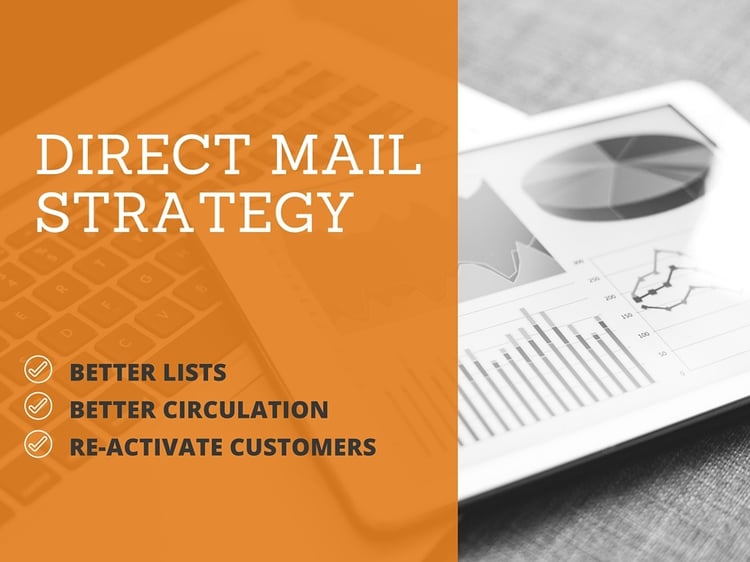If there’s one constant in the marketing landscape, it’s that marketing is always changing. New marketing technology sparks innovation in marketing practices and vice...

Your direct mail campaign is only as powerful as your distribution reach. In other words, a subpar list with disinterested prospects will result in the failure of any direct mail effort. To maximize your results, you need to take a step back and view how you can create a multifaceted approach that is reaching the right audience with the right direct mail piece at the right time.
Download our eBook "The Future of Direct Mail Circulation: How to Tap Into Buyer Intent to Improve Your Planning Effectiveness."The Campaign Strategy
You should never enter into a specific direct mail event without knowing your strategy for the entire campaign. Mapping out your campaign in advance will help you ensure that your circulation plan delivers the right media to the right audience at the optimal time. Forward planning will also allow you to manage contact frequency with active buyers much more effectively. It’s common for direct mail campaigns to run on a quarterly basis. Consider the seasonal catalogs distributed by large department stores. With each new season comes new styles, images and seasonal tone. It’s in a retailer’s best interest to capitalize on the changes that occur in the environment to provide their shoppers with what they want and need in the moment.
A quarterly approach goes beyond seasonal vibes. It gives you the flexibility necessary to incorporate changes to your circulation plan and audience segments. You should be continually looking at incoming sales patterns to evaluate who your prime consumers are and how they came to your company. Which shoppers are responding to your direct mail efforts and which aren’t? Are they not responding because the direct mail piece isn’t effective, or is it because they’re not your ideal customer?
Wading through transactional data, and then predicting the possible reasons for your buyers’ response, takes time and intimate knowledge of your industry and your audience. But with the advances in technology and data analytics, companies are learning how to read a shopper’s “digital body language”, which can help you understand the buyer’s intent on your company’s website. This insight is invaluable in allowing you to hone in on who is buying from your company, how they are buying, how frequently they are buying or if they’re visiting your site but going elsewhere to purchase. With the information you gather on those interested in your company’s products or services — whether they purchase from you or not — you can create a direct mail campaign that will provide existing customers or prospects with real value at the time they need it.
Your Audience Segments
Although you want to send out as many direct mail pieces as you have budgeted, you can’t send your materials to everyone at just any time. Developing defined segments for your shoppers can help you ensure the right people get your offer at the right time. Understanding your audience segments takes accurate analysis of the industry, your company and your consumers. And there’s more to understanding — and separating — your audience into segments than merely demographics or transaction history. Knowing what motivates your shoppers to purchase can also help you refine your mailing lists to provide an offer or catalog to that shopper when they are most likely to buy.
Identifying the attributes that define your responders will help your direct mail circulation planning in future cycles. It’s all about zeroing in on your core audience. The more work you do to identify your best customers, the more loyal those individuals will be to your company, and the better equipped you will be to identify “look alikes” who are likely to purchase from your brand. So let’s take a look at how to refine your lists for active buyers, lapsed buyers and prospects.
Active Buyers
A core objective of direct marketing circulation is getting your materials in the mailboxes of those people who are most likely to respond. Active buyers certainly fall into that category. Individuals who have bought your product have a demonstrated need for the products or services you provide. Give these people a compelling reason to consider your company’s offerings.
Multi-Buyers
Multi-buyers are your consumers who make regular purchases from your company. Of course, the more recent and frequent their purchases, the more valuable they are. While it’s easy to send every direct mail piece to them, these buyers are also very valuable sources of information, representing your ideal customer. Use your knowledge of them and their purchase habits to better identify lists for prospecting. Even inside of this active, multi-buyer segment, you can continue to segment. Separate full-price buyers from sale-buyers, gift-givers from those who are shopping for themselves and so on. The more refined your list is, the more personalized your approach can be.
And these loyal customers deserve to be rewarded and treated as more than people who will always automatically buy from your company. Make sure you continue to show them how much you appreciate them with offers and rewards for being with your company over a long period of time.
One-Time Buyers
A one-time buyer is someone who has made a purchase from you, but only one. They can be defined as “tryers,” rather than buyers, since they have not demonstrated any propensity to return to your brand. Maybe your company had a sale on dress shirts that had a high response rate, but many of these buyers, while recent, haven’t purchased anything since. They might not become lifetime customers, but with the right touch, they could. Using intent data can help you see if these one-time buyers may become more than that. If they’re showing interest by visiting your website regularly, then make sure you’re sending them direct mail pieces that encourage them to come back.
Lapsed Buyers
Customers drift away from brands for a variety of reasons, but it doesn’t mean they’re lost forever. Re-engaging these customers with offers that are relevant to them is worth the investment, and with today’s knowledge and technology, it’s getting easier to know who to target with your reactivation efforts.
Buyer Intent
It’s easier than ever for you to reach out to lapsed customers. Modern technology gives you the ability to identify activity that signals intent on the part of a former customer to re-familiarize themselves with your brand. This means that if a former customer visits your website, you can find out when they visited, how long they visited and any areas of the site in which they showed particular interest. You can then use this information to send out a personalized direct mail piece, with a compelling call to action, enticing them to once again patronize your company.
Database Co-Ops
Another way to identify former customers who may be ready to consider your company again is through database co-ops. While your records might show a given customer hasn’t made a purchase in many years, a database co-op may indicate that this customer is in fact an active consumer for a related product. It’s a great way to see which of your former customers is most likely to do business with you again, making those consumers great additions to your mailing list.
Prospects
Sending direct mail pieces to unknown entities can be a gamble that results in added expenses and diminished conversion rates. However, an educated approach will help you to maximize the effectiveness of your prospecting, making this a major part of your direct mail circulation planning; one that will help you grow your customer file.
Intent Data
Just as you used intent data to gauge the interest of lapsed customers, you can also use online activity to identify prospects who have shown interest in making purchases. This is a great way to generate relevant prospects with a strong chance of taking action on your direct mail offer because these buyers have shown interest by visiting your website and searching your products. Understanding how to find and use the data your website collects can provide you with new insights into who your target customers are and who is stopping just short of making a purchase.
List Vendors and Database Co-Ops
Names you acquire through database co-ops and list brokers can also help you expand your circulation in a measured manner. Going this route has one major benefit – you may be able to benefit from the customers of competing companies. Sending your best offers to people who support the competition may just encourage those prospects to give your product a shot.
Get More Out of Your Direct Mail Campaign
The importance of direct marketing circulation planning cannot be overstated; it’s your key to success. Careful research is vital because the more you know about your customers, the better you’ll be able to segment and target your audience. Using technology solutions to identify lapsed and potentially interested consumers will inject your distribution plan with new life, enabling you to continue to build your direct mail program in future campaigns. Actively refining and combining transactional data with intent data will help you get more out of your direct mail campaigns.

